Satin Sheets & Flying Down To Rio
Saturday, December 26, 2009
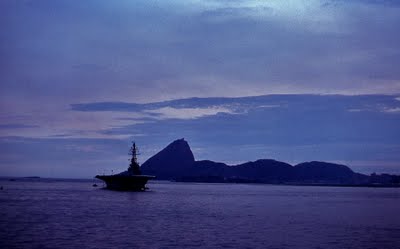
On December 1964 I flew from Mexico City to Buenos Aires via Panama and Rio de Janeiro. At the time there were few direct flights and if one booked carefully there were certain advantages to flying indirectly. For one it meant that I stayed overnight in Panama City in a luxury hotel, not far from the airport of Tocumen, courtesy of the airline (Pan American) which showed its appreciation for my having to adjust to the "discomfort" of indirectness. My memory is fuzzy but I do know that the bellboy who opened the door to my room, asked me if I wanted company for the night. He added that he could arrange for it. I declined. I was surprised to find that my sheets were light blue satin. It was the first and last time I ever slept between satin sheets.
The flight to Rio was in a most unusual jet plane. Few (only 37) had been built. It was a Brazilian Airlines Varig, Convair 990. Their claim to fame at the time was that they were faster (635MPH and according to my friend and airplane expert Sean Rossiter, the fastest subsonic airliner ever) than the then standard of the jet age, the Boeing 707. My 990 had four General Electric CJ805 turbojets that generated 16,500 lbs of thrust each which were the civilian versions of the J79 that powered the Lockheed F-104 and the McDonnell Douglas F4 Phantom.
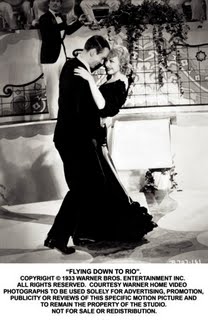
I had carefully chosen a Varig flight that did not have immediate connections to Buenos Aires. This meant that VARIG paid for my night at the Hotel Gloria. It was this hotel that had been featured in that film (all I remembered was that number where beautiful girls danced on the top of a monoplane while holding cables attached to the wing) Flying Down to Rio with Fred Astaire, Ginger Rogers and that most beautiful of actresses the Mexican Dolores del Río. The hotel had been at its apogee when Flying Down to Rio was made in 1933 it was a tad run down but still aware of its proud heritage. I was informed at the front desk that I was obliged to wear a suit and tie if I were going to dine at the hotel.
The dining room was a huge affair complete with a spiral staircase in one corner. I was the only patron. At any moment I imagined that Barbara Stanwyck might show up or that I was going to experience a dance duo, the Carioca, by Astaire and Rogers. That did not happen. A man in a full tuxedo came in and sat down at a grand, Steinway grand. He acknowledged my presence with a pursing of his lips and began to play flowery romantic piano sonatas. After my meal the also liveried waiter asked me if my meal had been to my satisfaction. I told him it had been. I didn't want to seem rude by pointing out that my Argentine compatriots would have said that the steak (it was tough) was "carne cansada" or tired meat which is the result of allowing cattle to roam at will for kilometers to get their food. Before leaving I went up to the piano player and asked him what a particular lugubrious piano piece had been. In perfect English he replied, “That was Mort! - Lamentation pour Piano by L.M. Gottschalk which the composer dedicated to his friend Monsieur Le Comte Gioannini."

The next morning at the airport there were only two passengers getting on the flight to Buenos Aires. I was one of them and the other was a burly middle-aged American. The Brazilian authorities told us we needed to have smallpox shot before we could get on the plane. We looked at each other as both of us had a document attached to our passports that attested to it. The burly man said he did not need a new vaccination and that this was duly recorded in his American passport. The Brazilian official told him that it was not considered an acceptable one as there was no legible date attached to the proof of inoculation. The American began to scream at the official, “We Americans have propped up your country with all type of aid and money. The least you can do is to show some appreciation and wave this.” It is my belief that the American arrived safely in Buenos Aires minus his smallpox inoculation but his luggage was probably sent to Montevideo. The Brazilian doctor, before he injected me with the vaccine, smiled at me and explained that the vaccine was not obligatory and that I had an option to pay and not get it. I decided that my best route was to indulge him so I bribed him. My luggage and I arrived at Buenos Aires.
A Cleverly Christmas Day
Friday, December 25, 2009
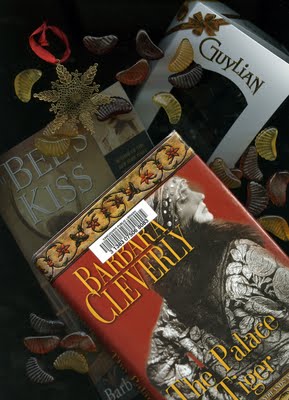 Because we celebrate Christmas on Christmas Eve and our granddaughters and parents go and visit their other relatives on Christmas Day we are left with a day to do nothing. For me that is the real spirit of Christmas Day. The late morning began with breakfast in bed (as usual). I brought up a tray with two glasses of orange juice, sliced bananas with brown sugar for Rosemary and toast (from Rebecca’s homemade bread for me. A mug of strong tea was for me while for Rosemary I brewed some of her decaf. The only newspaper (reading the newspaper is part of our early morning routine) was a Vancouver Courier. The NY Times does publish on Christmas Day but delivery is still curtailed in Vancouver. The Christmas edition is delivered on Boxing Day with the Boxing Day edition. I never did take off my nightgown and I only got out of bed during the day to replenish my tea and indulge in Christmas stocking goodies as my favourite (once-a-year) Guylian Belgian Chocolate Sea Shells, and Efruti fruit juice slices.  I read two books, Barbara Cleverly’s The Palace Tiger and The Bee’s Kiss. The latter transfers Scotland Yard Commander Joe Sandilands (bottom, right) back to his home in London after four novels in the The Raj of the 1920s. One of those four novels, Ragtime In Simla I have reserved at the Vancouver Public Library. They have only two copies and both are out. Perhaps I am not the only one on a Cleverly Christmas binge. Cleverly's four Raj Sandilands novels have re-injected an interest in all things British India (the Raj) so I have been consulting my copy of Velerie Pakenham's Out in the Noonday Sun - Edwardians in the Tropics. The re-reading of Pakenham's book suddenly put me into contact with a most interesting character that seems to have slipped my mind. It was ornithologist ( Birds of Arabia, 1930) Richard Meinertzhagen (1878-1967) who fought in India and East Africa and by the time he had command he used vicious tactics of reprisals called the Punjab Principle before settling in as a brilliant Intelligence Officer for General Allenby in the Palestinian campaign in WWI. Pakenham writes: 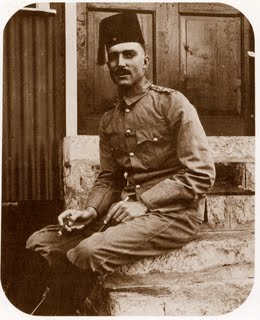 Richard Meinertzhagen found himself back in Europe early in 1917, seconded to the War Office, Kitchener's last disastrous post. Meinertzhagen had made himself a brilliant reputation in the East African capaign as Chief Intelligence Officer where he evolved a highly original method of collecting information about the enemy's strength and movement. He called it the D.P.M. - Dirty Paper Method - since it depended largely on salvaging jettisoned doucuments from the enemy's latrines. Richard Meinertzhagen found himself back in Europe early in 1917, seconded to the War Office, Kitchener's last disastrous post. Meinertzhagen had made himself a brilliant reputation in the East African capaign as Chief Intelligence Officer where he evolved a highly original method of collecting information about the enemy's strength and movement. He called it the D.P.M. - Dirty Paper Method - since it depended largely on salvaging jettisoned doucuments from the enemy's latrines.
...In December he was relieved to be posted to another sideshow - the Palestinian campaign, this time as Chief Intelligence Officer to Allenby, the first general for whom he soon had unstinted praise. He set up his D.P.M. system again to report on Turkish activities and in October carried out in person one of the war's most daring coups. He rode up alone within sight of the Turkish lines, near enough to be shot at, then, wheeling about, apparently wounded, he dropped a bloodstained haversack in mid-flight. The haversack contained carefully forged plans of a n Allied attack on the Turk's western front, among other personal documents; it fooled the Turks sufficiently to allow Allenby's real offensive a few weeks later to Beersheba to go through relatively unopposed. That Commnder Joe Sandilands dispatches two, over ten foot tigers, within minutes in The Palace Tiger with his Holland and Holland Royal double 23-inch barrel rifle does not in the least seem all that extraordinary when I read Pakenham's brief story on the fighting ornithologist!
Chicken A La Barbara & Toby Hams It Up
Thursday, December 24, 2009
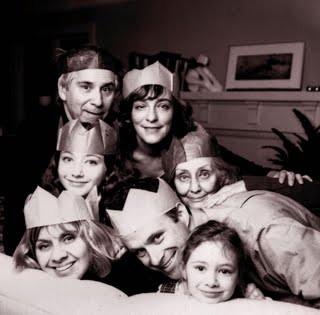
Sometime around 1971 my mother returned from a long stay with her brother Tony in North Carolina. I remember very well that she looked at me and said, “You have always thought me to be a terrible cook. You have been right, but now I am going to prove to the contrary. I can cook." She showed me a pocketbook which she had purchased in Greensboro, Marion Brown’s – Southern Cook Book , new edition, August 1970. She had tried some of the recipes under the supervision of Uncle Tony’s wife and most competent cook, Renate.
My mother cooked the most heavenly chicken I have ever had, Adalyn Lindley’s Chicken A La Barbara.
Serves Six to Eight
1 roasting chicken 1 stalk celery
1 cup flour Carrots, parsnips, parsley
Salt, celery salt, pepper 1 qt. water
paprika to taste 1 tablespoon flour seasoned
chicken giblets with salt and pepper
Tops of wings and neck ½ cup cream
Mix flour and seasonings and rub chicken inside and out with mixture. Melt ¼ pound of butter and rub over seasoned fowl. Take the chicken giblets, top of wings and neck, a celery stalk, carrots, parsnips and parsley (desired amount of each vegetable) and put into about 1 qt. of water. Cook like soup for 1 hour. Strain. Mix 1 tablespoon seasoned with salt and pepper with ½ cup cream. Thicken stock with this. Put the chicken in a hot oven until slightly browned. Every 15 minutes pour ¼ cup stock over. When it is used up put cover on chicken and let simmer in oven until done.Special permission, Adalyn Lindley, Manager, Neiman-Marcus Tea Room, Dallas Texas.
We had Chicken a la Barbara for our Christmas Eve dinner. I have made this recipe before so I have modified the recipe for a whole cup of cream and a half a qt more of stock. The sauce is so good that you need more to serve over the chicken and the white rice I usually serve it with. We had cucumber salad, roasted red, green, and yellow peppers with onion. To drink we had a BC rosé wine and ice cold spiced apple juice. For dessert Rebecca made cookies and a blueberry/apple pie from scratch. I had our special container that converts cream into real whipped cream.

Before we opened the presents I snapped a few Fuji instant b+w prints. One would have been enough except I overexposed the first one and Hilary systematically closed her eyes for the subsequent ones. In the end I liked and somewhat corrected the over-exposed one. The second picture features Rosemary’s 19-year-old cat Toby. Bruce Stewart made Toby look lively with some expert gesticulation.
To any who may be reading this blog I wish them a Merry Christmas.
Jo-Ann & A Hot Summer's Day In December
Wednesday, December 23, 2009
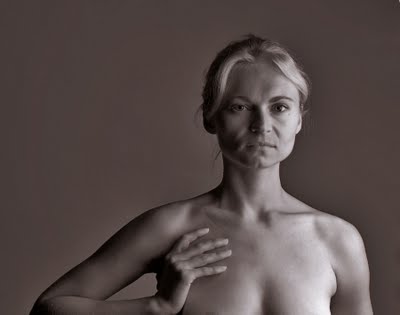 December 23 is a strange day. It is not Christmas Eve, it is not Christmas. There is a fine lethargy to the day in which I usually do nothing but read and drink tea. I did just that today, nothing. But the blog beckoned and I had to think of something. I looked at the mess that is a winter garden and imagined it in the spring again. Then I thought about the heat of summmer, those rare Vancouver summer days when it is really hot. Those are the days that are dearest to my heart. They bring in nostalgia for the heat of Mexico or of my native Buenos Aires. Indeed December 23 is usually one of the hottest days of the Buenos Aires summer. But today the heat took me to my files of Jo-Ann, the Thursday Girl. In late summer I took pictures of Jo-Ann the "Thursday Girl" who came to my studio a few Thursdays per year beginning in 2006. Here you see one of the first pictures and one of the last, on the roof of my studio. Jo-Ann is of Dutch origin and perhaps that suggests to me that she has a 15 century Flemish painting kind of face. It is strong. She shows confidence and equanimity. For some strange reasons few of my pictures of her are my usual portraits or nude portraits. She somehow blends into the backgrounds and becomes a whole with it. 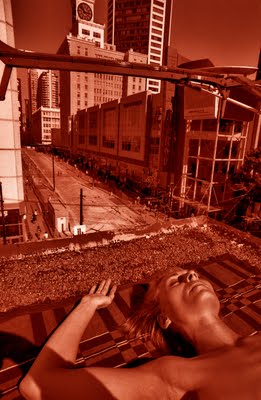 The first picture is one of the most remarkable nudes I feel I have taken. Unfortunately I had to crop it because of my policy of not showing full nudes in my blog. Her hand is perfect and she projects in the full nude the stability of the Golden Gate Bridge. I am not in any way intimating that she is not slim. She is! The second picture which I have tinted red suggests to me the heat of that day in early September. You cannot "see" the noises that were coming from the pneumatic hammers that were drilling into the intersection of Robson and Granville. The ruckus did not faze Jo-Ann in the least. I dislike reading the newspapers at this time of the year with their “year in pictures” or “the year that was”. I noticed a picture today in the NY Times of Bush looking out of the window of his not-quite-the-presidential-helicopter as he left DC. It seems a century ago. I don’t want to look at more of those pictures. I want to look at pictures of Jo-Ann on the roof of my studio on a hot afternoon. It is my hope that Jo-Ann will not discontinue our Thursdays.
The Christmas Gift - The Record
Tuesday, December 22, 2009
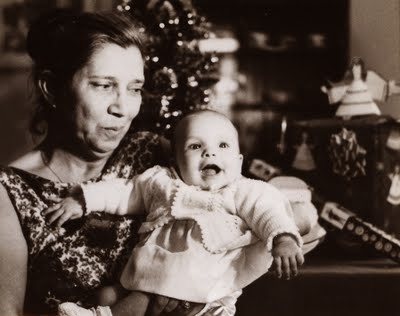 I have written on these pages (screens?) before here about my mother’s first love and the fact that she never made me forget that my father somehow was her second choice. By the logic of the little boy that I was (and in some ways I still am) I came to the conclusion that I, too was second best. That first love in Manila in the late 30s ended in a revelation that I suspect but have refused until now to explore further. I think I will leave it for another year. That first love somehow disappointed my mother who then threw an opal ring into Manila Bay and soon after she, her mother, brother and sister moved to Buenos Aires where by 1942 I entered the picture. When my mother died we had her notebook of poems bound in beautiful leather. It is called Things and Thoughts after one of the poems. It is only in the last few years that I have come to realize to what point my mother was obsessed in her love for Doctor Ramón Andía. The notebook begins in Mexico City in 1955. There are poems written in Nueva Rosita, Coahuila and Veracruz, Veracruz and ends February 1972 in Mexico City (from our home in Arboledas) a year before her death. I hinted that the casting of the ring into Manila Bay was the result of a thick letter that Dr. Andía wrote to my mother. This letter was at my mother’s side and is now in the centre drawer of my desk here, as I type this. From a Filipino wedding in North Vancouver where I met a nephew of Ramon Andía I found out he never married. Another relative was more candid and told me, “Dr. Andía was gay.” Below you will find two poems one is called The Record and is dated Dec 10, 1956. My mother would have written this poem in Nueva Rosita, Coahuila, Mexico as well as the second one, The Christmas Gift dated, Dec 13, 1956. I will copy them in reverse order. In light of what I have written about Dr. Andía above, you might catch on to the subtlety in which my mother writes of her despair. The Christmas Gift
What shall I get you for Xmas?
A silver bell that’s tinkle you to merriness,
A candy cane, some sugared plums, nuts and raisins,
So you’ll taste the sweetness of Xmas cheer?
“That’s not for me.”
Is this more appropriate?
A staid plum pudding dipped in rhum,
A bottle of golden apple cider,
An eggnog with cinnamon and nutmeg,
And spices from the east.
A fat red Xmas candle dustily aglitter with snowflakes,
A silver star with a shiny tail like a comet?
(All these have the evergreen tang of the many Xmases I didn’t share with you.)
You stare at me & shake your head,
And I must say, “Oh it’s just a fantasy.”
I still wonder
What shall I get you for Xmas?
The Record
He came along sheepishly
A record behind his back
And nonchalantly said,
“I brought you a record
It was mine and now it is yours.”
It was an old-fashioned 78
Nicked at the edges; played very often
It’s jacket was thumbed and worn.
I thought to myself,
“Couldn’t he find something better?”
And then I looked at the two titles
One the first side I read, “I Love You Truly”
On the other, as finishing a sentence
“Nevertheless.”The photograph is of my mother holding our 4-months-old first daughter Ale. It was Christmas 1968 in Veracruz, Mexico
Supersedure
Monday, December 21, 2009
 While in the pay of the Argentine navy I was seconded to the US Naval Advisory Group. This meant that I had a secretary and lots of privileges that many of my fellow Argentine conscripts. I had access to large tins of Edgeworth pipe tobacco and other goodies that came from the PX. But I had to such boring and onerous tasks as filing US Naval reports. Many were bulletins that superseded earlier ones. I had to find the older documents and replace them with the new ones. The idea was that the superseded document could contain dangerous instructions that had not been caught until the new bulletin came in. The verb supersede was a popular verb in the US Navy and I really don’t think that replace quite means the same thing. As a way of showing this I have as an example a photograph I took of Rebecca when she must have been two or three. When Rosemary saw it she smiled and loved it. In fact in was her favourite for some years. The frame is over the fireplace mantel of our den. If I were to put it away Rosemary would notice immediately.  For me the picture has been superseded by all the rest that came after. I cannot even look at the picture with the nostalgia of the little girl that was. Rebecca is much more interesting as she grows up. There is a superficiality (of someone who has not lived enough to have any kind of depth) in her cuteness that contrasts most unfavourably with her present self. She is more dynamic, more intelligent and more argumentative. She is almost an adult and I find her to be a good friend. I wonder if this latest picture which I took on Saturday will soon be superseded by something else.
Pancho Does Not Smile For Christmas
Sunday, December 20, 2009
 Sunday was really the first day of our Christmas holiday. Rosemary and I lingered in bed reading the Sunday New York Times and after feeding the cats, they came back and we stayed in bed. I continued reading Barbara Cleverly’s (no relation to Penelope Lively) The Last Kashmiri Rose which is a novel that is part of her series set in 1920s British Imperial India and features a Scotland Yard investigator and Flander’s Field veteran, Inspector Joe Sandilands. I was hooked when my neighbour Patricia Hutter lent me The Damascene Blade. Staying in bed to read without feeling guilty and keeping our financial worries buried (just a bit) is what Christmas is all about. The two girls arrived in the morning to find the Douglas Fir tree I had purchased earlier. Rosemary strung up the lights and Lauren and Rebecca did the decorations. My not so subtle cultural “indoctrination” was not to be interrupted by the holidays so I put on a CD of Lotte Lenya singing Kurt Veil’s The Seven Deadly Sins and Berlin Theatre Songs. Rebecca found her odd and after looking at her picture said she was ugly. But I think she began to tolerate the voice. The important factor is that she has been exposed. As contrast I put on my CD of J.J. Johnson and Andre Previn playing the music of Kurt Weil. Our friend Paul Leisz gave us a turkey for Christmas but Rebecca insisted in cooking it herself at home yesterday. We had a sumptuous pre-Christmas dinner at Rebecca’s (and Lauren’s, Hilary’s and Bruce’s) last night. For me it was a special pleasure (and a bit of a relief) to not have to cook or wash the dishes. Everybody was there including Rebecca and Lauren’s other grandparents. We left early in the evening and I got into bet to continue with The First Kashmiri Rose. What to post for yesterday’s blog? I came up with the idea of showing our tree (if only in b+w) so I took a Fuji instant print of Lauren with Pancho, who was given to us by Abraham Rogatnick last year. We will miss him for Christmas Eve. Lauren said to Pancho, “Please don’t smile.” Pancho, much in character, obeyed her.
|





















